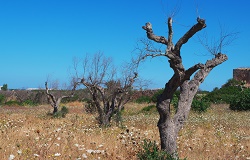Protecting olive trees from a deadly disease
Xylella fastidiosa (XF) is a bacterium which has been linked to a number of plant diseases, particularly in the Americas where it has ravaged peaches, grapevines and citrus fruits. However, more recently the pathogen has attacked olive trees in Southern Italy and since 2013 has invaded over 23 000 ha of olives. After causing terminal shoots to wither, the disease spreads to the whole canopy causing the trees to die, affecting all of the other trees in the groves. The XF-ACTORS project aims to assess the likelihood of pathogen spread through EU territories, as well as set up prevention, early detection and control protocols for XF. The project team have used modelling to help predict the spread of the pathogen and in so doing are able to advise on the establishment of buffer zones to protect uninfected trees. Modelling to predict XF spread Recently published research in the journal ‘Biological Invasions’ by members of the team, outlines the project approach which is to model control zones currently deployed in Apulia, Italy in order to replicate the pattern of disease spread. The re-searchers found that when the buffer width is increased, infection risks are indeed decreased beyond the control zone, but may not stop the spread completely. As the lead author Dr. Steven White is quoted as saying, ‘At these early stages of Xylella fastidiosa invasion, little is known about the rates of spread of this terrible disease of olive trees and how best to control it. This is largely due to biological and environmental differences between where the strain is invading and where it has originated.’ In order to understand the process better, the study also looks specifically at how the spread of XF across Europe - and beyond - might be influenced by a range of insects mobile between groves. Introducing an integrated management strategy XF-ACTORS will examine the pathogen biology underpinning the disease (along with that of the hosts under threat), as well as the pathogens epidemiological traits to better understand its subsequent progression. Additionally, there will also be a focus on investigation of insect-bacteria interactions. Beyond yielding scientific information, the project will design effective phased control strategies giving policy makers tools to contain the risk of further spread beyond Italy. This step-by-step approach looks to first prevent the pathogen’s introduction into uninfected areas, for example by implementing EU certification programs alongside developing a plan for an EU Clean Plant Network. Additionally, field-ready surveillance systems utilising remote sensing technology will be developed for early detec-tion. When infection does occur, effective eradication strategies will be established for deployment. The project will also put pest risk assessment tools at the disposal of Policy makers which will focus on any contemporary outbreaks and indicate which regions are likely to come under threat next. The project will work in tandem with an-other EU funded project - PONTE – whose research aims are complementary. When an outbreak does occur, it is hoped that this approach will be able to reduce its social, economic and environmental impact. As co-author of the study, Dr Daniel Chapman says, ‘Our study shows that simple models can help to plan disease management strategies in the early stages of an epidemic. Thanks to new funding from the European Union, we will be further developing the approach to provide specific guidance on surveillance, containment and even eradication of new outbreaks.’ For more information visit XF-ACTORS: CORDIS project page
Countries
Italy



